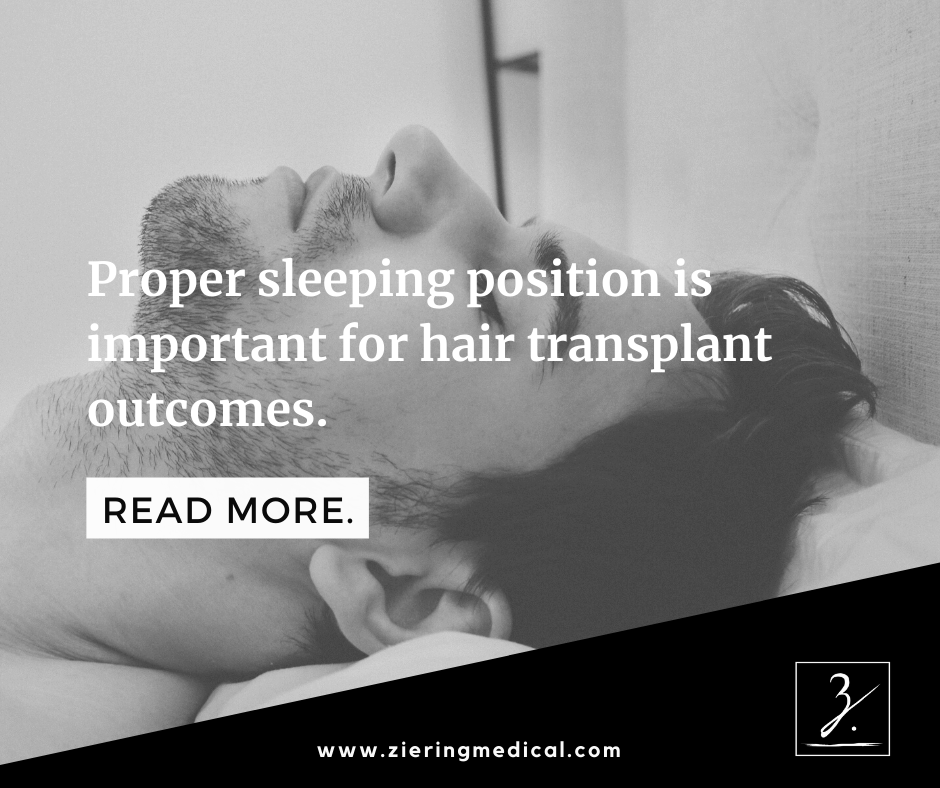Getting Comfortable Sleep After FUE Hair Transplant

Dr. Craig Ziering is a leading hair restoration surgeon and at his practice, Ziering Medical, he offers cutting-edge Follicular Unit Extraction (FUE) hair transplant surgeries to his patients. This advanced form of surgical hair restoration achieves excellent, natural looking results for patients. But the surgery itself is just the first step of the process. It’s also equally important to provide and be prepared with optimal conditions for healing and recovery during the postoperative period. This will promote ideal outcomes for both the patient’s hair transplant and their general comfort and sense of well-being during this time.
Patient comfort and hair restoration outcomes are connected. If the patient’s recovery process is proceeding as planned, they shouldn’t experience a high-level of discomfort. Conversely, if there are complications, this will be reflected on the surgical site and the patient will feel discomfort or excess pain. Additionally, sleep loss can negatively affect the wound healing process. This means getting comfortable sleep after a FUE hair transplant goes hand-in-hand with proper aftercare and recovery.
How FUE Works
During Follicular Unit Excision and Extraction, or the (FUE) Hair Transplant, the donor area on the back and sides of the head are shaved. Then the surgeon harvests your donor hair one graft at a time. Next, the surgeon creates recipient sites where the harvested hair grafts are gently and meticulously placed at the proper angle and orientation by the surgery technicians.
FUE provides an alternative to Microscopically Dissected Elliptical Excision (MDEE, formerly known as FUT), which entails harvesting a thin strip of tissue and dissecting that tissue into individual follicular units of one to four hairs.
FUE addresses patient concerns about having a thin linear scar from MDEE procedures. Due to being less invasive, FUE also entails a shorter recovery period. It is often the choice procedure for those patients who wear their hair short. The same applies to those who have scalps that are too tight for strip harvesting.
Proper Sleeping Position
Proper sleeping position is important for hair transplant outcomes because during the first days after the operation, the hair grafts and scalp are rather delicate. Patients must refrain from disturbing newly placed grafts. By sleeping at a 45 degree angle, they can prevent this from happening and help make sure they heal properly with their grafts intact.
For at least 4 nights after the surgery, those who underwent FUE must sleep with their head and back slightly elevated. A recliner would be ideal for this. This is because during the first nights after the operation there is a risk of swelling. Due to this, an elevated position will help keep scalp and forehead swelling down and speed up the recovery. Gravity will help fluids drain, or prevent them from accumulating, at the operative site.
When lying on their back, patients should rest their head at a 45 degree angle on a soft pillow. Tossing and turning must be avoided as the movement may dislodge grafts. Patients used to sleeping on their bellies must refrain from doing so as that position might contribute to post-surgery swelling as well as dislodging the newly transplanted hair grafts.
Use Clean Sheets and Pillowcases
The use of clean bed sheets and pillowcases is an obvious step as the surgical site will be vulnerable to contamination and infection during the healing process. Extra care must be taken, especially in the first few days after surgery, to ensure the cleanliness of the bed, pillow cases and sheets. This reduces the risk of infection. Bed linens should be washed with detergent free of any allergens that could irritate the scalp.
Use Towels to Absorb Drainage
For the first few days after the operation, some drainage may come out of the scalp while it heals. To avoid staining pillows, towels or cloths can be placed over them to absorb any leakage as the scalp heals.
How Long Until I Can Sleep Normally?
Typically, patients can return to their normal routine and activities at least 10 to 14 days after surgery. Aside from resuming normal sleeping positions and patterns, patients can also return to their standard physical activities, hair washing and more.
When Do Hair Transplant Grafts Become Secure
Hair grafts and incisions on the scalp take around 7 to 10 days to heal. To be secure and rooted to the recipient area they take 8 to 14 days. The time it takes will depend on patient adherence to postoperative care routines and precautions.
Other Postoperative Instructions
Patients can help facilitate a smoother healing and recovery process following a FUE hair transplant by taking the following steps:
- Refraining from physical activities or exercises that can raise the heart rate or cause perspiration. Sweating will cause the scalp to itch and is not suitable for hair grafts. It may also cause your hair grafts to become dislodged.
- Avoid smoking and drinking alcohol, which affect blood supply to the head.
- Have a balanced diet full of nutrients and antioxidants that promote healing and keep hydrated.
- Avoid exposing the scalp to direct sunlight for the first two weeks after surgery and avoid getting any sunburn on the transplanted areas for the first three months.
Takeaway
For more information regarding hair transplant and postoperative instructions, reach out to Ziering Medical to schedule a consultation. A one-on-one consultation at Ziering Medical is the best way to determine which treatment is best suited for your unique needs. We go to great lengths to ensure our patients have the best possible experience with their hair restoration surgery and get optimal natural-looking results. Ziering Medical has clinics in Beverly Hills, California; Greenwich, Connecticut; and New York City, New York.






